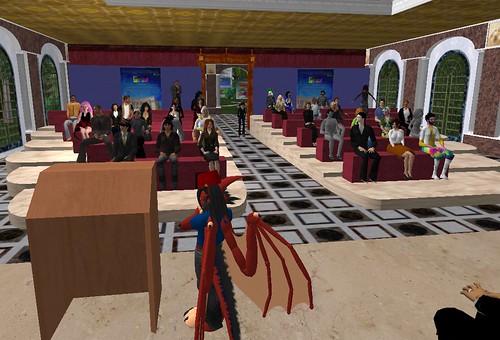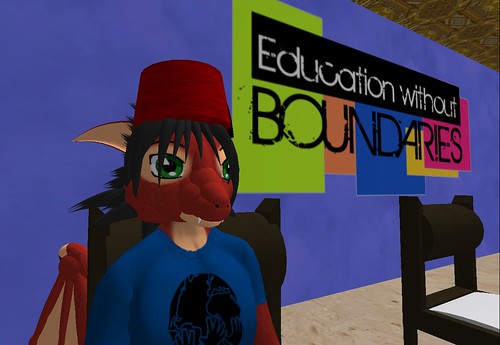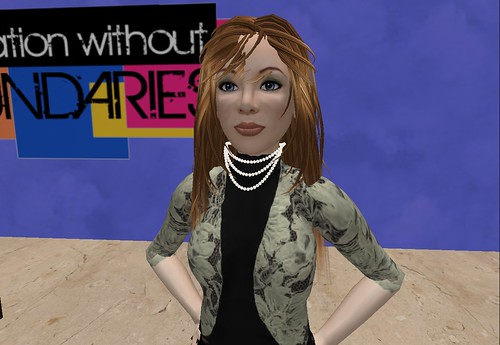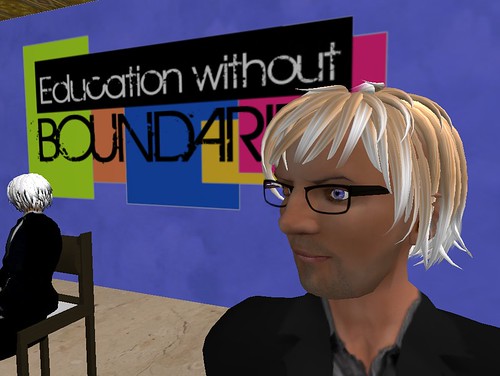
Today I got the privilege to speak to an international audience of about 50 avatars about the work of Global Kids at a US State Department event called "Education Without Boundaries." It took place on USC’s lovely Annenberg Island in Second Life (click here to teleport). I was among a distinguished panel of educators including Ken Hudson of Loyalist College (Canada), Christopher Keesey of Ohio University, and Sue Shick of Case Western. The panel was gently moderated by Bill May of the State Department Bureau of International Information Programs.
Since I knew that the other panelists were going to be presenting their work using virtual worlds for different kinds of simulations and distance learning environments, I wanted to contrast this with Global Kids’ more participatory, youth-driven learning approach. I think this complemented the other presentations very nicely.
I presented about Global Kids constructivist learning approach to education. I began by asking for a show of yes’s in the open chat of who had heard of the constructivist approach, and luckily lots of people were already familiar with it. Basically this pedagogical framework involves engaging the student as an active learner, creating some tangible product that encompasses their learning process.
What Motivates You? Youth-Driven Learning
All of our work is designed to tap into youth interests and motivations – music, theater, poetry, gaming, etc. Our "Playing 4 Keeps" program enables young people to work with a game developer to create a digital game on a serious social issue of their choice. I directed them to check out our Playing 4 Keeps game "Ayiti: The Cost of Life" about poverty and education in Haiti.
Empowering Young People to be Seekers of Information
We help kids strategize about how to find information, using peer-to-peer learning. Our "I Dig Tanzania" Summer Camp enabled kids in New York and Chicago tp work together in Teen Second Life to create virtual exhibits on fossils in Tanzania based on information gathered from current field work, internet research, their peers.
Learning by Doing
Global Kids sees the act of creation as the final step in the learning process – whether its a piece of 3D artwork, an activist campaign, or even a movie. Our Virtual Video Project works with young people to help them create a short machinima movie on a social issue that they care about. One of our VVP videos "A Child’s War" has been viewed nearly 10,000 times and won several awards.
Sharing Your Work
We situate virtual worlds in the larger online participatory culture. All of our teens are required to blog about their experiences in our programs, which helps us and them track their progress. We also use Social Networks like Facebook, Myspace and our own social networks we create like the Youth Media Exchange network that we created to support young social media creators around the world.
I concluded that the Global Kids constructivist approach was particularly well suited to virtual worlds where you can literally reconstruct the world or "rez reality." Using these spaces we can connect the global to the local, and the abstract to the personal.
Sue Shick of Case Western talked about their work creating different simulations for their students at Case Western. These included several medical applications, such as a simulated patient that medical students could interview and the use of simulations to reduce perceived pain.
Chris Keesey of Ohio University presented some of work that they were doing in virtual worlds, from 3D artwork to a game on food choices. He announced that Ohio U plans to offer a "Virtual World Certification" program starting in 2009, which sounds very interesting. I really liked his emphasis on context as being very important, not only as educators but also acknowledging that the students should have a role in modifying the context of their own learning environment to best meet their needs and be relevant to them.
Lastly Ken Hudson of Loyalist College talked about their work to create a simulated border crossing in Second Life. Students could assume the role of a Canadian border guard in Second Life, interviewing people as they cross the border and learning about the challenges of working in that environment. He reported a very high rate of retention of knowledge from this simulation, compared to more traditional means of teaching this content. And now the actual Canadian border service is thinking of using a similar simulation in their trainings of their border guards.




Math and Reading Help for Kids is a growing directory of original articles and resources centered on the topic of children’s education. The purpose of this site is to provide a centralized information portal to help parents and children make informed decisions about school and further studies in future related issues.
————–
Samflutch
Influencer